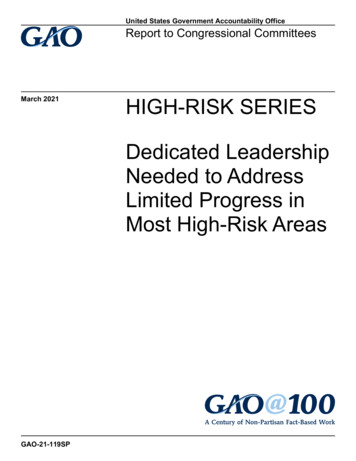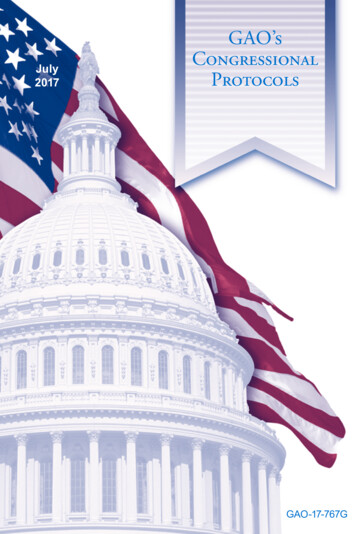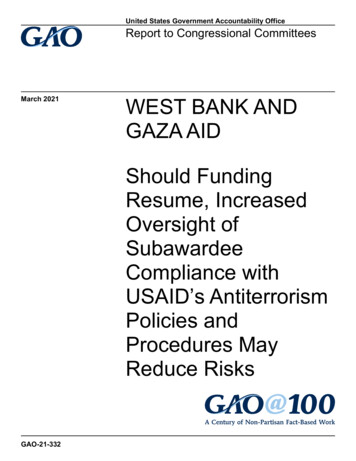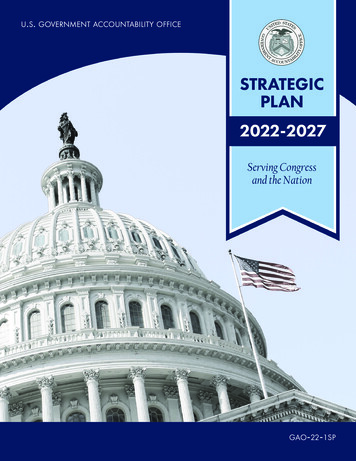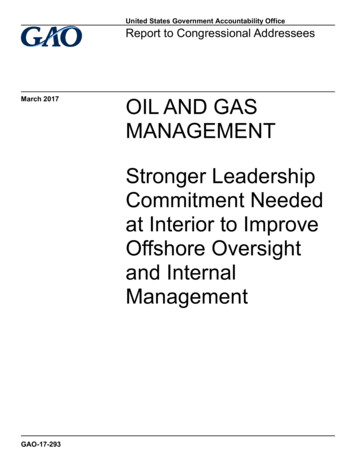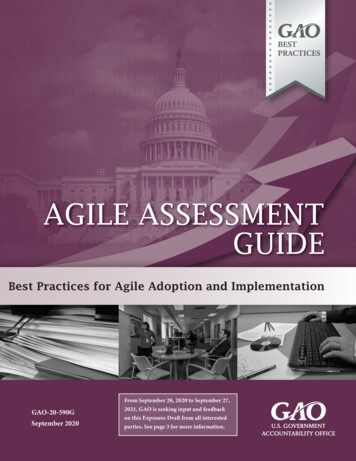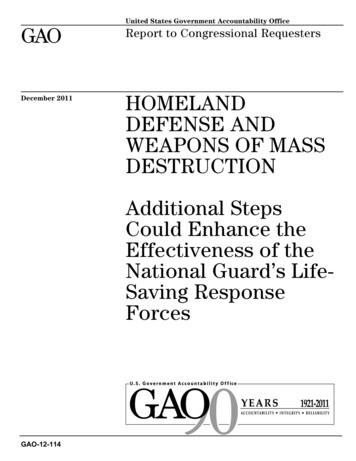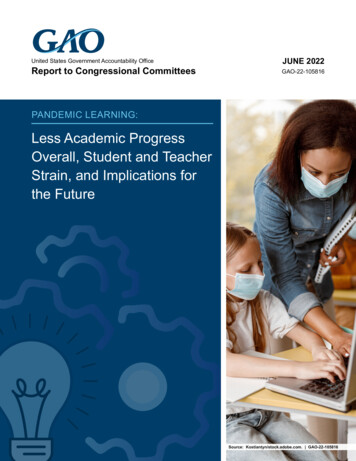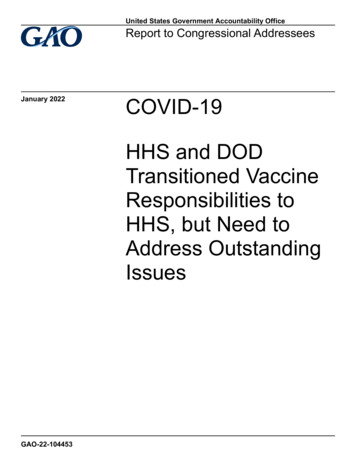
Transcription
United States Government Accountability OfficeReport to Congressional AddresseesJanuary 2022COVID-19HHS and DODTransitioned VaccineResponsibilities toHHS, but Need toAddress OutstandingIssuesGAO-22-104453
January 2022COVID-19HHS and DOD Transitioned Vaccine Responsibilitiesto HHS, but Need to Address Outstanding IssuesHighlights of GAO-22-104453, a report tocongressional addresseesWhy GAO Did This StudyWhat GAO FoundVaccines have played a crucial role inbattling the COVID-19 pandemic. TheCAG worked with vaccine companiesto develop COVID-19 vaccines, andmade available a sufficient supply forall eligible people in the nation. AnApril 2021 memorandum ofunderstanding between HHS and DODcalled for the transfer of remainingCAG responsibilities to HHS and foridentification of lessons learned.Starting in May 2020, federal efforts to accelerate the development,manufacturing, and distribution of COVID-19 vaccines had been led by apartnership between the Department of Health and Human Services (HHS) andthe Department of Defense (DOD). Formerly known as Operation Warp Speed,the partnership was renamed the HHS-DOD COVID-19 CountermeasuresAcceleration Group (CAG). According to HHS and DOD officials, the CAGdissolved and transitioned its responsibilities—including DOD-led vaccineactivities—to HHS by December 31, 2021, as required by an April 2021memorandum of understanding between the two departments.Manufacturing of COVID-19 VaccinesThe CARES Act includes a provisionfor GAO to report on its ongoingmonitoring and oversight efforts relatedto the COVID-19 pandemic. This reportexamines, among other things, theCAG’s progress on (1) transitioning itsresponsibilities to HHS, and (2)developing a process for a jointinteragency lessons learned review.GAO reviewed CAG transition andcontracting documents and interviewedor received written responses fromCAG officials, federal agencies, andrepresentatives from the six vaccinecompanies that worked with the CAG.What GAO RecommendsGAO is making five recommendationsrelated to workforce needs, schedulingbest practices for vaccine-relatedactivities; and lessons learned fromkey stakeholders.HHS did not concur with GAO’srecommendation on workforce needs.GAO revised this recommendationbased on updated information, butmaintains that it continues to be valid,as discussed in the report.View GAO-22-104453. For more information,contact Alyssa M. Hundrup at (202) 512-7114or hundrupa@gao.govWhile HHS and DOD officials said they achieved transition milestones indicatingthat HHS is ready to assume responsibilities formerly led by DOD, it is unclearhow HHS will address its workforce needs now that the CAG has dissolved.Specifically, GAO found that HHS has assessed its workforce capabilities, butlacks strategies for addressing these workforce needs. By formally providing itssupport until HHS develops and implements these strategies, DOD can helpensure that HHS can continue these responsibilities uninterrupted, includingresponsibilities for addressing ongoing vaccine needs for boosters or for anyemerging COVID-19 variants. Moreover, HHS does not have a schedule that isconsistent with best practices to help it manage remaining vaccine-relatedactivities. Such a schedule could help HHS better plan actions and mitigatedelays, and be a source for identifying lessons learned for any future pandemics.The CAG developed a plan for conducting a joint, interagency lessons-learnedreview. This plan outlines an approach for collecting information—such asperspectives on challenges—from CAG staff, and for sharing the plan with HHS.However, the plan misses an opportunity to gather perspectives from keyexternal stakeholders, including vaccine companies, critical to developingvaccines. Obtaining these perspectives could provide a more comprehensiveunderstanding of areas where the CAG was successful and opportunities forimprovement, which could help inform HHS’s ongoing and future vaccine work.United States Government Accountability Office
ContentsLetter1BackgroundCAG Transitioned to HHS, but HHS Readiness to Assume AllResponsibilities UnclearThe CAG Began a Lessons-Learned Review Process, but ItsPlans Do Not Include Collecting Information from StakeholdersPreliminary Lessons Learned from the CAG, Federal Agencies,and Vaccine Company RepresentativesConclusionsRecommendations for Executive ActionAgency Comments and Our Evaluation22272829Status of U.S. COVID-19 Vaccine Candidates and RelatedObligations and Doses34Contract Techniques Used to Obtain COVID-19 Vaccines forthe U.S.38Abridged Assessment of the Countermeasures Acceleration Group’sSchedule42Appendix IVComments from the Department of Health & Human Services45Appendix VComments from the Department of Defense48Appendix VIGAO Contact and Staff Acknowledgments51Appendix IAppendix IIAppendix IIIRelated GAO Products691952Page iGAO-22-104453 HHS-DOD CAG Partnership
TablesTable 1: Nine Lines of Effort for Transitioning DODResponsibilities in the CAG to HHSTable 2: Status of the CAG’s Six Vaccine Candidates, as ofJanuary 11, 2022Table 3: Vaccine Doses Contracted for Purchase by the FederalGovernment for Domestic Use, as of October 22, 2021Table 4: Assessment of the CAG’s Integrated Master Schedule,June 202111343743FiguresFigure 1: Leading Practices of a Lessons-Learned ReviewProcessFigure 2: HHS and DOD Obligations for COVID-19 VaccineCandidates and Others under the CAG, as of September30, 2021Page ii2036GAO-22-104453 HHS-DOD CAG Partnership
AbbreviationsASPROffice of the Assistant Secretary for Preparednessand ResponseBARDABiomedical Advanced Research and DevelopmentAuthorityCAGHHS-DOD COVID-19 CountermeasuresAcceleration GroupCAG Continuity Book DOD’s Countermeasures Acceleration GroupContinuity BookCDCCenters for Disease Control and PreventionCOVID-19Coronavirus Disease 2019DODDepartment of DefenseDPADefense Production ActEUAemergency use authorizationFARFederal Acquisition RegulationFDAFood and Drug AdministrationHHSDepartment of Health and Human ServicesJPEO-CBRNDJoint Program Executive Office for Chemical,Biological, Radiological, and Nuclear DefenseNIHNational Institutes of HealthOTAother transaction agreementThis is a work of the U.S. government and is not subject to copyright protection in theUnited States. The published product may be reproduced and distributed in its entiretywithout further permission from GAO. However, because this work may containcopyrighted images or other material, permission from the copyright holder may benecessary if you wish to reproduce this material separately.Page iiiGAO-22-104453 HHS-DOD CAG Partnership
Letter441 G St. N.W.Washington, DC 20548January 19, 2022Congressional AddresseesSince the President declared the Coronavirus Disease 2019 (COVID-19)pandemic a national emergency on March 13, 2020, the country hasreported more than 56 million confirmed cases and more than 830,000deaths as of January 3, 2022, including a sharp increase in cases at theend of December 2021 due largely to the Omicron variant. 1 In the secondyear of the pandemic’s catastrophic effects, the federal government’sefforts to help develop and make available an adequate supply of safeand effective vaccines have been crucial to the nation’s ongoing recovery.It is also critical that the federal government learn from its experienceswith accelerating vaccine production so that it can be prepared to meetfuture vaccine needs for this pandemic—such as to counteract theemergence of new variants—or for future pandemics. 2To help make safe and effective vaccines available as quickly aspossible, in April 2020, the federal government announced the creation ofOperation Warp Speed, a partnership between the Department of Healthand Human Services (HHS) and the Department of Defense (DOD). InApril 2021, Operation Warp Speed was renamed the HHS-DOD COVID19 Countermeasures Acceleration Group (CAG), and for the purposes ofthis report, we refer to both iterations of this partnership as the CAG.The CAG was set up to support the acceleration of vaccine development,manufacturing, and distribution to states, other jurisdictions, and federalagencies and programs for vaccine administration. 3 As a part of those1Inaddition to declaring a national emergency under the National Emergencies Act, thePresident also declared a nationwide emergency under section 501(b) of the Robert T.Stafford Disaster Relief and Emergency Assistance Act and approved major disasterdeclarations for all 50 states, the District of Columbia, five territories, and three federallyrecognized Indian tribes. On January 31, 2020, the Secretary of Health and HumanServices declared a public health emergency for the United States, retroactive to January27, 2020.2Asof January 2022, the Centers for Disease Control and Prevention (CDC) had listed theDelta and Omicron variants as variants of concern in the U.S. CDC had previouslycharacterized three other variants (Alpha, Beta, and Gamma) as variants of concern butlater downgraded them.3Jurisdictionsinclude all 50 states, the District of Columbia, eight U.S. territories, and asmall number of major cities.Page 1GAO-22-104453 HHS-DOD CAG Partnership
efforts, HHS and DOD awarded contracts and other transactionagreements (OTA) to six vaccine companies and others for thedevelopment and manufacturing of vaccines, the purchase of vaccinedoses, and the acquisition of other critical supplies and services. 4 TheCAG also coordinated with other external stakeholders, including federalagencies, such as the Centers for Disease Control and Prevention (CDC),on vaccine distribution planning, according to officials. 5In December 2020, the first two COVID-19 vaccines—sponsored byModerna and Pfizer—were authorized by the Food and DrugAdministration (FDA) for emergency use. 6 The CAG began distributingdoses of these vaccines to states and others immediately upon theirauthorization. As of January 2022, three COVID-19 vaccines (with thethird sponsored by Janssen) were available in the United States. 7 Pfizer’s vaccine was licensed for individuals ages 16 and older andwas also available under an emergency use authorization (EUA) forindividuals ages 12 to 15 years, as a lower dose for individuals ages 5to 11 years, as a third dose for certain immunocompromisedindividuals ages 5 years and older, and as a booster for individualsages 12 years and older.4OTAs are flexible agreements that allow the parties to negotiate terms and conditionswithout requiring parties to comply with certain federal procurement laws and regulations.See 10 U.S.C. § 2371b. For more information on the accelerated COVID-19 vaccinedevelopment process, see GAO, Operation Warp Speed: Accelerated COVID-19 VaccineDevelopment Status and Efforts to Address Manufacturing Challenges. GAO-21-319,(Washington, D.C.: Feb. 11, 2021).5Formore information about the CAG, see our April 2021 report on the federalgovernment’s vaccine efforts. GAO, COVID-19: Efforts to Increase Vaccine Availabilityand Perspectives on Initial Implementation. GAO-21-443 (Washington, D.C.: Apr. 14,2021).6TheSecretary of Health and Human Services may declare that circumstances,prescribed by statute, exist justifying the emergency use of certain medical products, suchas vaccines. Once a declaration has been made, FDA may temporarily allow use ofunlicensed vaccines through an emergency use authorization (EUA). For FDA to issue anEUA for a vaccine, it must be reasonable to believe that the vaccine may be effective andthat the known and potential benefits of the vaccine outweigh the known and potentialrisks, among other statutory criteria. See 21 U.S.C. § 360bbb-3. Pfizer developed itsCOVID-19 vaccine in collaboration with BioNTech.7JanssenPage 2Pharmaceutical Companies are a part of Johnson & Johnson.GAO-22-104453 HHS-DOD CAG Partnership
Moderna’s vaccine was authorized for individuals ages 18 and older,as a third dose for certain immunocompromised individuals ages 18an older, and as a booster for individuals ages 18 and older. Janssen’s vaccine was authorized for individuals ages 18 and olderand as a booster for the same population. 8By September 2021, the federal government had acquired over 673million doses of these three vaccines, sufficient to fully vaccinate 373million people, in line with the CAG’s overall goal of having sufficient adultvaccines for the American public. 9An April 2021 memorandum of understanding between HHS and DODcalled for the two departments to coordinate plans to transition the CAG’sresponsibilities to HHS, including activities that had been led by DOD.The memorandum also called for HHS and DOD to develop a jointinteragency process for incorporating lessons learned from the CAG’swork into HHS’s continued operations, and to dissolve the CAG byDecember 31, 2021.The CARES Act includes a provision for us to report on the federalresponse to the COVID-19 pandemic. Specifically, the act requires us tomonitor and oversee the federal government’s efforts to prepare for,respond to, and recover from the pandemic. 10 This report is part of ourbody of work in response to the CARES Act and focuses on the activitiesof the CAG. 118Allthree vaccines (Janssen, Moderna, and Pfizer) were also authorized for use as aheterologous (or “mix and match”) booster for individuals ages 18 years and older, as ofJanuary 2022.9Accordingto CDC, as of October 2021, people were considered “fully vaccinated” 2weeks after their second dose in a two-dose series, such as the Pfizer or Modernavaccine, or 2 weeks after a single-dose vaccine, such as the Janssen vaccine. As ofJanuary 11, 2022, the term “fully vaccinated” did not include boosters.10Pub. L. No. 116-136, § 19010, 134 Stat. 281, 579-81 (2020). This report also responds,in part, to a bipartisan request from the House Select Subcommittee on the CoronavirusCrisis for GAO to examine Operation Warp Speed (renamed the CAG in April 2021).11We have regularly issued government-wide reports on the federal response to COVID19. For the latest report, see GAO, COVID-19: Additional Actions Needed to ImproveAccountability and Program Effectiveness of Federal Response, GAO-22-105051(Washington, D.C.: Oct. 27, 2021). Our next government-wide report will be issued inJanuary 2022 and will be available on GAO’s website at https://www.gao.gov/coronavirus.Also, see the GAO Related Products section at the end of this report for additional workwe have done on COVID-19 vaccines.Page 3GAO-22-104453 HHS-DOD CAG Partnership
In this report, we1. examine the CAG’s progress on transitioning responsibilities to HHSfor developing, manufacturing, and distributing COVID-19 vaccines;2. examine the CAG’s progress on developing a joint interagency reviewprocess to identify lessons learned from its COVID-19 vaccinedevelopment, manufacturing, and distribution efforts; and3. describe preliminary lessons learned we obtained from the CAG,selected federal departments, and vaccine company representativeswho coordinated with the CAG on COVID-19 vaccine development,manufacturing, and distribution.To address the first objective, we reviewed documents pertaining to theCAG’s transition efforts, including the April 2021 memorandum betweenHHS and DOD, and the CAG’s July 2021 transition plan. Specifically, wereviewed the CAG’s transition readiness, including its efforts to establishmilestones to gauge its progress towards transition readiness, as requiredby the April 2021 memorandum, and compared these efforts to selectedleading practices for agency reforms, including transitions, which weidentified in prior work. 12 We also reviewed the CAG’s efforts to assessHHS’s workforce capacity to assume the CAG’s responsibilities and todevelop workforce strategies to address any workforce capacity gaps. Wealso then compared these efforts to selected leading practices for bothagency reforms and strategic workforce planning. 13 We also obtainedinformation on the CAG’s plans to assess the need for continued use ofcertain tools for tracking and managing remaining vaccine development,12Specifically,we assessed HHS’s transition readiness efforts against the followingselected agency reform leading practices: (1) developing an implementation plan with keymilestones and deliverables to track implementation progress; (2) establishing a dedicatedimplementation team to manage the reform process; and (3) designating leaders to beresponsible for the implementation of the proposed reforms. See GAO, GovernmentReorganization: Key Questions to Assess Agency Reform Efforts, GAO-18-427(Washington, D.C., June 13, 2018).13Specifically,we assessed HHS’s efforts to assess its workforce capacity against theleading practice for agency reform that agencies conduct strategic workforce planning todetermine whether they will have the needed resources and capacity, including the skillsand competencies, in place for the proposed reforms or reorganization. See GAO-18-427.In addition, we also assessed these efforts against selected leading practices for strategicworkforce planning, including that agencies should determine the critical skills andcompetencies needed to achieve programmatic results and develop strategies to addressgaps in critical skills and competencies. See GAO, Human Capital: Key Principles forEffective Strategic Workforce Planning, GAO-04-39 (Washington, D.C., Dec. 11, 2003).Page 4GAO-22-104453 HHS-DOD CAG Partnership
manufacturing, and distribution activities. We compared HHS’s plans tomanage the scheduling of vaccine development, manufacturing, anddistribution activities to best practices for scheduling, as outlined in theGAO Schedule Assessment Guide. 14 In addition, we conducted anabridged assessment of the CAG’s schedule as of May 11, 2021. 15To address the second objective, we reviewed documentation on theprogress the CAG had made as of October 2021 to develop a jointinteragency review process to identify lessons learned from its COVID-19vaccine efforts. We interviewed CAG officials about its joint, interagencyplan to develop a lessons-learned process. We compared the CAG’slessons-learned plan to leading practices we and others have previouslyidentified for conducting a lessons-learned process, such as collectingand disseminating lessons learned. 16 We also compared the departments’plans with the Project Management Institute’s program managementstandards, which call for program managers to engage with keystakeholders. 17To address the third objective, we reviewed DOD’s CountermeasuresAcceleration Group Continuity Book (CAG Continuity Book), which14SeeGAO, Schedule Assessment Guide: Best Practices for Project Schedules, GAO-1689G (Washington, D.C.: Dec. 22, 2015).15Our abridged assessment of the CAG’s schedule focused on the extent to which it was“well-constructed,” as defined in the GAO Schedule Assessment Guide. The “wellconstructed” characteristic is one of four general characteristics associated with highquality schedules, according to the guide, and we focused on it for this abridgedassessment because it reflects basic quality measures of a schedule.16See GAO, Federal Real Property Security: Interagency Security Committee ShouldImplement a Lessons-Learned Process, GAO-12-901 (Washington, D.C.: Sept. 10, 2012);and Project Management: DOE and NNSA Should Improve Their Lessons LearnedProcess for Capital Asset Projects, GAO-19-25 (Washington, D.C.: Dec. 21, 2018).Department of the Army, Combined Arms Center, Center for Army Lessons Learned,Establishing a Lessons Learned Program: Observations, Insights, and Lessons (FortLeavenworth, KS: June 2011).17Project Management Institute, Inc., A Guide to the Project Management Body ofKnowledge (PMBOK Guide), Sixth Edition, 2017; Project Management Institute, Inc.,Implementing Organizational Project Management: A Practice Guide, First Edition, 2014.PMBOK is a trademark of Project Management Institute, Inc. The PMBOK Guide.provides guidelines for managing individual projects, including collecting requirements anddefining the project’s scope. The Project Management Institute is a not-for-profitassociation that provides global standards for, among other things, project and programmanagement. These standards are utilized worldwide and provide guidance on how tomanage various aspects of projects, programs, and portfolios.Page 5GAO-22-104453 HHS-DOD CAG Partnership
highlighted information about lessons learned that DOD officials within theCAG documented over the course of the CAG’s COVID-19 responseefforts as of May 2021. 18 In June and July 2021, we also obtained writtenresponses or interviewed representatives from the six vaccine companiesthat were awarded contracts or OTAs under the CAG—AstraZeneca,Janssen, Moderna, Novavax, Pfizer, and Sanofi—about their experiencesworking with the CAG on vaccine development, manufacturing, anddistribution. We also interviewed officials from the CAG and componentoffices and agencies of HHS and DOD about their perspectives onactivities that worked well and any challenges they identified with theCAG’s COVID-19 vaccine response efforts in June and July 2021. WithinHHS, we interviewed or obtained written responses from officials from theOffice of the Assistant Secretary for Preparedness and Response(ASPR), Biomedical Advanced Research and Development Authority(BARDA), CDC, FDA, and the National Institutes of Health (NIH). WithinDOD, our interviews included officials from the Joint Program ExecutiveOffice for Chemical, Biological, Radiological, and Nuclear Defense(JPEO-CBRND) and the Army Contracting Command. We selected theseoffices and agencies because the CAG indicated that they were integralto the CAG’s vaccine efforts.We conducted this performance audit from July 2020 to January 2022 inaccordance with generally accepted government auditing standards.Those standards require that we plan and perform the audit to obtainsufficient, appropriate evidence to provide a reasonable basis for ourfindings and conclusions based on our audit objectives. We believe thatthe evidence obtained provides a reasonable basis for our findings andconclusions based on our audit objectives.BackgroundA June 2020 memorandum of understanding between HHS and DODestablished the CAG, then called Operation Warp Speed, with the primarypurpose of accelerating the development, production, and distribution ofCOVID-19 vaccines. (See appendix I for information on the status ofvaccine candidates and obligations made under the CAG.)The CAG was co-chaired by the Secretaries of Health and HumanServices and Defense, who appointed HHS and DOD officials to lead fivekey initiatives: (1) vaccine development; (2) therapeutics; (3) supply,18CAG officials from DOD said they provided the CAG Continuity Book to incoming CAGpersonnel when they joined the partnership. DOD officials developed it to capture keypersonnel’s mission, work streams, and lessons learned.Page 6GAO-22-104453 HHS-DOD CAG Partnership
production, and distribution; (4) security and assurance; and (5) research,development, acquisition, and contracting. 19 In addition, the CAG had anHHS Chief Advisor, an HHS Chief Operating Officer, and a DOD Chief ofStaff. 20As of September 2021, DOD had assigned 76 officials from the Army, theNavy, the Air Force, and the Marine Corps to work on the CAG’s five keyinitiatives. HHS officials told us that the department generally did notassign a specific number of staff to work directly on the CAG, but statedthat hundreds of officials from various HHS agencies, such as ASPR,CDC, and NIH, have worked on CAG-related efforts.DOD Designated Lead forMost Vaccine-RelatedCAG ActivitiesThe April 2021 memorandum of understanding between HHS and DODdesignated DOD as the lead for implementing most vaccine-relatedinitiatives within the CAG, with HHS to provide support. In particular, thememorandum tasked DOD with designating DOD officials to serve in thefollowing roles, leading three of the five key initiatives: Director of vaccine development—directed and oversaw developmentand testing of vaccines in coordination with the six vaccine companiesthat were part of the CAG; Director of supply, production, and distribution—implemented andoversaw acquisition of supplies and vaccines, including having DODofficials embedded in vaccine production factories to assist withsupply chain management and development of a federalgovernmental plan to distribute these items to the jurisdictions andother federal agencies and programs; and Director of security and assurance—developed security measures forthe CAG, and a security plan to support production and distribution ofvaccines and supplies from the development phase to distribution.The April 2021 memorandum also identified lead roles for DOD and HHSon the two other key initiatives. The memorandum indicated that officialsfrom both departments shared responsibility for overseeing and19Thisreport focuses primarily on the CAG’s vaccine-related responsibilities.20The Chief Advisor was responsible for providing technical advice regarding vaccinedevelopment and manufacturing and coordinated CAG activities with other federaldepartments. The Chief Operating Officer was responsible for coordinating the logistics,supply chain, development, production, and delivery of vaccines, as well as supportingHHS efforts under the CAG. The Chief of Staff supported the Chief Operating Officer inleading the CAG.Page 7GAO-22-104453 HHS-DOD CAG Partnership
supporting the research, development, acquisition, and contractinginitiative, and it tasked HHS with designating a director to lead thetherapeutics initiative.Plans to Transition CAGResponsibilities to HHSLeading Practices forAgency ReformsThe April 2021 memorandum between HHS and DOD tasked HHS andDOD to jointly develop a plan to transition all CAG responsibilities to HHSand fully dissolve the CAG by December 31, 2021, with transitionactivities to begin in the fall of 2021. 21 The April 2021 memorandumstated that the transition plan was to include a cross-walk plan that transfers DOD activities to HHS, key milestones that must be achieved to ensure successful transition, synchronization of transition planning to ensure uninterrupted support,communications, and decision-making related to ongoing vaccinerelated activities, and full incorporation of current efforts and lessons learned into the U.S.National Vaccine Program. 22Reforming and reorganizing the federal government is a major endeavorthat can include refocusing, realigning, or enhancing agency missions,including transitions. We have previously identified leading practices forfederal agencies to follow when planning and implementing agencyreforms. 23 Examples of these leading reform practices include identifying leaders to be responsible for the implementation of theproposed reform; establishing a dedicated implementation team that has the capacity,including staffing, resources, and change management, to managethe reform process;21The original June 2020 memorandum between HHS and DOD specified that theirpartnership would be in place until January 31, 2021. However, on January 14, 2021, HHSand DOD extended their partnership until May 2021. Then, through their April 2021memorandum, HHS and DOD further extended their partnership until the end ofDecember 2021, and renamed it the CAG.22The U.S. National Vaccine Program is located in the Office of the Assistant Secretary forHealth within HHS. The program was established in 1986 and is responsible for theresearch, development, and testing of all types of vaccines, such as for the influenza andother infectious diseases, as well as the production, procurement, and distribution ofvaccines to the public, among others.23SeeGAO-18-427.Page 8GAO-22-104453 HHS-DOD CAG Partnership
developing an implementation plan with key milestones anddeliverables to track implementation progress; and conducting strategic workforce planning to determine whether the newagency will have the needed resources and capacity, including theskills and competencies, in place for the proposed reform.CAG Transitioned toHHS, but HHSReadiness to AssumeAll ResponsibilitiesUnclearThe CAG Completed itsTransition to HHS inDecember 2021In July 2021, the CAG established a team led by co-chairs from DOD andHHS for transitioning all of the CAG’s responsibilities—particularly thoseled by DOD—to HHS. The CAG also developed a transition plan, ascalled for in the April 2021 memorandum of understanding between HHSand DOD. These steps are consistent with selected leading reformpractices identified in our prior work, which highlight the importance ofestablishing a dedicated implementation team and plan when an agencyundergoes an agency reform, such as a transition.As part of the transition plan, CAG officials developed a crosswalk—asrequired by the April 2021 memorandum—to guide the incrementaltransfer of DOD-led responsibilities to HHS. Specifically, the crosswalkorganized the transition of responsibilities from DOD to HHS into ninelines of effort. 24 These lines of effort identified DOD-led responsibilitiesacross the CAG’s five key initiatives that HHS was to assume as part ofthe transition (see table 1). According to CAG officials, ASPR was theHHS office in charge of leading the transition of CAG responsibilities,including those led by DOD, to HHS. 25 In addition, CAG officials told usthat a new office within ASPR, called the HHS Coordination Operationsand Response Element, would be responsible for continuing all of the24CAG officials told us in October 2021 that DOD officials led all nine lines of effort.However, HHS officials told us in January 2022 that the Legal line of effort and theResearch and Clinical Trials for Vaccines and Therapeutics line of effort were alreadysupported by HHS officials and therefore were not transitioned from DOD to HHS.25ASPRserves as the principal advisor to the Secretary of Health and Human Services onall matters related to federal public health and medical preparedness and responses forpublic health eme
Page ii GAO-22-104453 HHS-DOD CAG Partnership . Tables Table 1: Nine Lines of Effort for Transitioning DOD Responsibilities in the CAG to HHS 11 Table 2: Status of the CAG's Six Vaccine Candidates, as of January 11, 2022 34 Table 3: Vaccine Doses Contracted for Purchase by the Federal Government for Domestic Use, as of October 22, 2021 37
